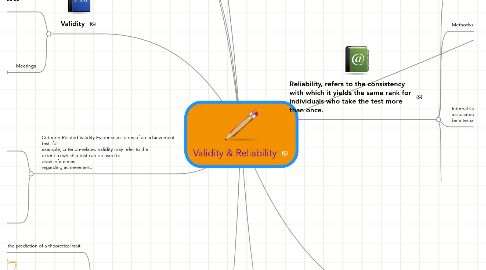
1. Criterion-Related Validity Evidence,in terms of an achievement test, for example, criterion-related validity may refer to the extent to which a test can be used to draw inferences regarding achievement.
1.1. Concurrent criterion-related: is determined by adminstering both the new test & the established test to a group of respondents, then finding the correlation between the two sets fo test scores.
1.2. predictivevalidity evidence; is how well the test calculates some future behavior of the examinees use for apititude test, which attempts to predict how well test takers will do in some future setting.
2. Validity is the range to which a test measures what it claims to measure. It is vital for a test to be valid in order for the results to be accurately applied and understood.
3. Validity
3.1. Content Validity Evidence, Is established by inspecting test questions to see whether they relate to what the user decides should be covered by the test.
3.1.1. Refers to the extent to which the test questions represent the skills in the specified subject area.
3.1.2. Did the process ensure that the collection of items represent appropriate skill?
3.2. Meetings
3.2.1. Meeting 1
3.2.2. Meeting 2
4. Construct Validity Evidence,
4.1. Construct Validity, it has validity if it demonstrates an association between the test scores and the prediction of a theoretical trait
4.2. To demonstrate that the items within a measure are inter-related and therefore measure a single construct
4.2.1. Task 1
4.2.2. Task 2
4.3. "Any information that lets you know whether results from the test correspond to what you expect( based on your knowledge about what is being measured) tells something about the construct validity evidence for a test."Kubiszyn & Borich 2010)
4.3.1. Call 1
4.3.2. Call 2
4.4. Meetings
4.4.1. Meeting 1
4.4.2. Meeting 2
5. example, criterion-related validity may refer to the extent to which a test can be used to
6. draw inferences regarding achievement.
7. New node
8. Developing improved test with less chance of measurement error is better than only recording the amount of error. Measurement error is reduced by writing items clearly, making instructions easily understood, following to proper test administration, and dependable scoring.
9. Reliability, refers to the consistency with which it yields the same rank for individuals who take the test more than once.
9.1. If any use is to be made of the information from a test, it is necessary that the test results be reliable.
9.2. Methods>
9.2.1. Test-Retest- the test is given twice and the connection between the first set of scores and the secon set is firm. p. 341
9.2.2. Clear measure of score consistency
9.3. Internal Consistency- objects must be associated with each other, and the test must be internally consistent.
9.3.1. Kuder-Richardson Methods
9.3.2. Split-half
9.4. Meetings
9.4.1. The correlation of scores on pairs of alternative forms for the same examinees provides another measure of consistency & reliability.
10. Testing & Assessment
10.1. Priority
10.2. Tasks
10.2.1. Task 1
10.2.2. Task 2
10.3. Phone Calls
10.3.1. Call 1
10.3.2. Call 2
10.4. Meetings
10.4.1. Meeting 1
10.4.2. Meeting 2
